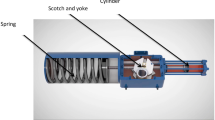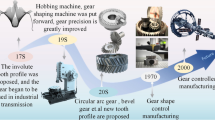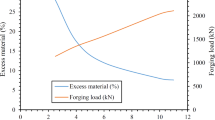Abstract
In this study, the weight loss of brake pad in automotive brake system was investigated using Taguchi’s method. Wear tests of the brake pad versus cast iron disk were carried out for a dry sliding condition in a so-called a pad-on-disk rig. The wear tests were realized at the sliding speeds of 7, 9, and 11 ms−1 and under the pressures of 0.5, 1, and 1.5 bars. The obtained lowest weight loss for the brake pad contains the copper flake volume fraction of 20 % by weight under the same test conditions. The experimental results are transformed into a signal-to-noise (S/N) ratio using Taguchi method. Volume fraction of copper flake, pressure, and interaction between volume fraction of copper flake and pressure exert a great effect on the weight loss, at 58.11, 16.35, and 20.86 %, respectively. The estimated S/N ratios of the weight loss, using the optimal testing parameters, were calculated and a good agreement was observed between the predicted and actual weight loss, with a confidence level of 99.5 %.



Similar content being viewed by others
References
Mutlu I, Eldogan O, Findik F (2006) Tribological properties of some phenolic composites suggested for automotive brakes. Tribol Int 39:317–325
Jang H, Ko K, Kim SJ, Basch RH, Fash JW (2004) The effect of metal fibers on the friction performance of automotive brake friction materials. Wear 256:406–414
Anderson AE (1992) Friction, lubrication, and wear technology. ASM Handb 18:569–577
McLellan RG (1988) Requirements of friction materials in commercial vehicle disk brake applications. I Mech E C451(88):9–13
Rhee SK, Jacko MG, Tsang PHS (1991) The role of friction film in friction, wear and noise of automotive brakes. Wear 146:89–97
Jacko MG, Tsang PHS, Rhee SK (1989) Wear debris compaction and friction film formation of polymer composites. Wear 133:23–38
Williams JA (1999) Wear modelling: analytical, computational and mapping: a continuum mechanics approach. Wear 225–229:1–17
Stanford MK, Jain VK (2001) Friction and wear characteristics of hard coatings. Wear 251:990–996
Wirth A, Whitaker R, Turner S, Fixter G (1994) X-ray photoelectron spectroscopy characterization of third body layers formed during automotive friction braking. J Electron Spectrosc Relat Phenom 68:675–683
Handa Y, Kato T (1996) Effects of Cu powder, BaSO4 and cashew dust on the wear and friction characteristics of automotive brake pads. Tribol Trans 39:346–353
Howell GJ, Ball A (1995) Dry sliding wear of particulate-reinforced aluminium alloys against automobile friction materials. Wear 181–183:379–390
Qi HS (1995) A contact length model for grinding wheel–workpiece contact. Ph.D.thesis, Liverpool John Moores University, UK
Boz M, Kurt A (2000) Relationship between density and friction coefficient in powder metal bronze brake lining, vol 1. In: Second international conference on P/M, Romania, pp 181–187
Zhang Y, Chen Y, He R, Shen B (1993) Investigation of tribological properties of brake shoe materials-phosphorous cast irons with different graphite morphologies. Wear 166:179–186
Cueva G, Sinatore A, Guesser WL, Tschiptschin AP (2003) Wear resistance of cast irons used in brake disc rotors. Wear 255:1256–1260
Aleksendric D (2010) Neural network prediction of brake friction materials wear. Wear 268:117–125
Ross PJ (1996) Taguchi techniques for quality engineering. Tata McGraw-Hill, New York
Kapsiz M, Durat M, Ficici F (2011) Friction and wear studies between cylinder liner and piston ring pair using Taguchi design method. Adv Eng Softw 42:595–603
Ficici F, Kapsiz M, Durat M (2011) Applications of Taguchi design method to study wear behaviour of boronized AISI 1040 steel. Int J Phys Sci 6(2):237–243
Acknowledgments
The authors would like to thank the Eren Balata AS for financial and technical supports.
Author information
Authors and Affiliations
Corresponding author
Additional information
Technical Editor: Fernando Antonio Forcellini.
Rights and permissions
About this article
Cite this article
Ficici, F., Durat, M. & Kapsiz, M. Optimization of tribological parameters for a brake pad using Taguchi design method. J Braz. Soc. Mech. Sci. Eng. 36, 653–659 (2014). https://doi.org/10.1007/s40430-013-0115-x
Received:
Accepted:
Published:
Issue Date:
DOI: https://doi.org/10.1007/s40430-013-0115-x




